Discover the world of easy to care for hanging house plants and bring a touch of nature into your home with minimal effort. From selecting the perfect plants to troubleshooting common issues, this guide provides all you need to create a thriving indoor oasis.
With their graceful foliage cascading down, hanging plants add a touch of elegance and freshness to any space. Whether you’re a seasoned plant enthusiast or a beginner looking for low-maintenance greenery, this guide will help you choose and care for the best hanging plants for your home.
Selecting Easy-Care Hanging Houseplants
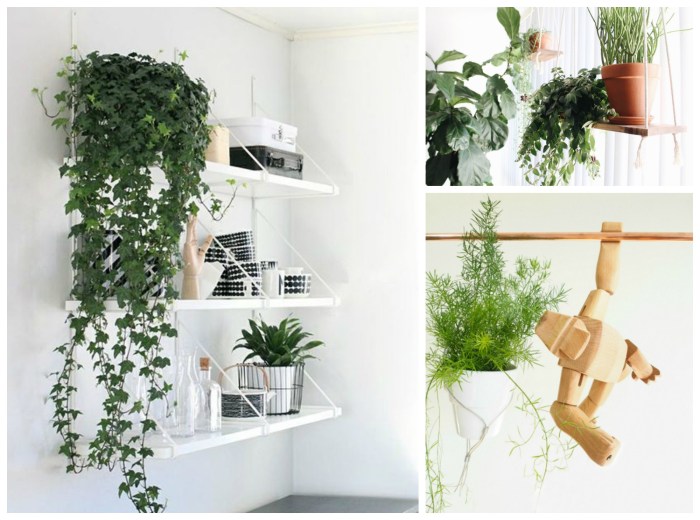
Hanging plants are a great way to add greenery to your home without taking up too much space. But not all hanging plants are created equal. Some require a lot of care and attention, while others are relatively low-maintenance. If you’re looking for a hanging plant that will thrive with minimal effort, here are a few things to keep in mind:
Light requirements:Most hanging plants prefer bright, indirect light. However, some plants, such as the pothos and spider plant, can tolerate low-light conditions. If you don’t have a lot of natural light in your home, you may want to choose a plant that is tolerant of low light.
Watering needs:Hanging plants typically need to be watered less frequently than other plants. This is because the soil in a hanging pot dries out more slowly than the soil in a regular pot. However, you should still check the soil regularly and water the plant when it feels dry to the touch.
Growth habits:Some hanging plants, such as the ivy and wandering Jew, can grow quite long. If you don’t want a plant that will take over your entire window, you may want to choose a plant that has a more compact growth habit.
Recommended Easy-Care Hanging Houseplants
- Pothos:The pothos is a popular hanging plant because it is easy to care for and can tolerate a wide range of light conditions. It is also a fast-growing plant, so it can quickly fill up a space.
- Spider plant:The spider plant is another easy-care hanging plant that is tolerant of low light. It is also a non-toxic plant, so it is safe for pets and children.
- Ivy:Ivy is a classic hanging plant that is known for its trailing vines. It is a relatively low-maintenance plant, but it does require regular watering.
- Wandering Jew:The wandering Jew is a fast-growing hanging plant that is known for its colorful leaves. It is a relatively low-maintenance plant, but it does require regular watering.
- String of pearls:The string of pearls is a unique hanging plant that is known for its long, trailing stems. It is a relatively low-maintenance plant, but it does require regular watering.
Optimal Growing Conditions for Hanging Plants
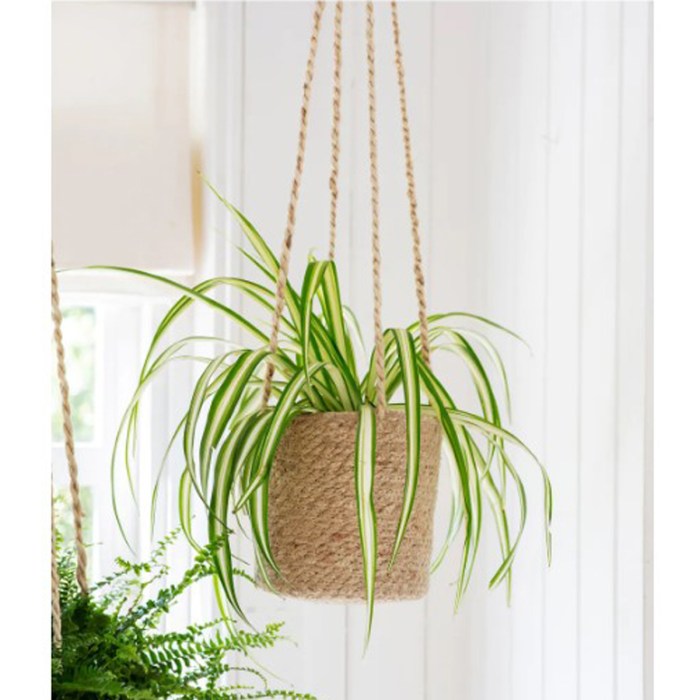
Hanging plants add a touch of greenery and elegance to any space. However, providing them with the right growing conditions is crucial for their health and longevity.
Lighting Conditions
Different types of hanging plants have varying lighting requirements. Bright indirect light is ideal for most plants, as it provides ample light without causing sun damage. Plants that can tolerate low light include pothos, snake plants, and ZZ plants. Direct sunlight can be beneficial for certain succulents, such as string of pearls and jade plants.
Watering Techniques
Proper watering is essential for hanging plants. Allow the soil to dry out slightly between waterings to prevent overwatering. Water thoroughly until water drains from the drainage holes, then discard any excess water from the saucer. Plants with thick, succulent leaves, like hoyas and succulents, require less frequent watering.
Humidity Levels
Some hanging plants, such as ferns and orchids, prefer higher humidity levels. To increase humidity, mist the leaves regularly or place the plant on a tray filled with pebbles and water. A humidifier can also be used to create a more humid environment.
Creative Display Ideas for Hanging Plants
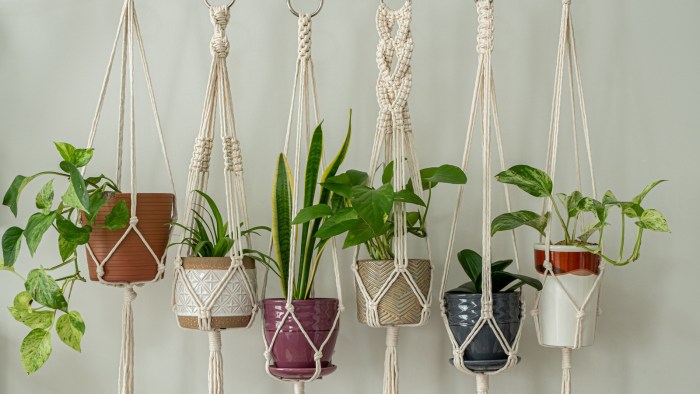
Hanging plants are a fantastic way to add a touch of nature to your home décor while also purifying the air. But how do you display them in a way that is both stylish and functional? Here are a few creative ideas:
One of the most popular ways to display hanging plants is to use macrame hangers. These hangers are made of knotted cords and can be hung from the ceiling or a wall. They come in a variety of styles, so you can find one that matches your décor.
Another option is to use wall-mounted brackets. These brackets are attached to the wall and can hold one or more hanging plants. They are a good choice if you want to create a vertical garden effect.
Ceiling Hooks
Ceiling hooks are a simple and inexpensive way to hang plants from the ceiling. They are available in a variety of sizes and finishes, so you can find one that suits your needs. To hang a plant from a ceiling hook, simply screw the hook into the ceiling and then hang the plant from the hook.
Vertical Garden Effect
If you want to create a vertical garden effect, you can combine multiple hanging plants in a space-saving arrangement. To do this, simply hang the plants at different heights and in different locations. You can also use a variety of different plants to create a more interesting look.
Natural Room Dividers
Hanging plants can also be used as natural room dividers. To do this, simply hang the plants in a line between the two spaces that you want to divide. The plants will help to create a sense of separation while still allowing light and air to flow between the spaces.
Add a Touch of Greenery
Hanging plants can also be used to add a touch of greenery to specific areas of your home. For example, you can hang a plant in a corner of your living room to add a bit of life to the space.
Or, you can hang a plant in your kitchen to add a touch of freshness to the room.
Troubleshooting Common Issues with Hanging Plants
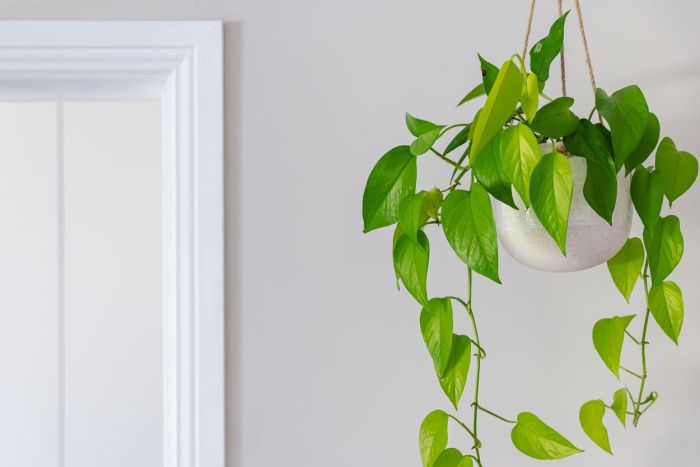
Hanging plants add a touch of greenery and elegance to any home, but they can also be prone to certain problems. By understanding the causes and solutions for these common issues, you can keep your hanging plants healthy and thriving.
Regular inspection and maintenance are crucial for preventing and addressing potential problems. Check your plants regularly for signs of distress, such as yellowing leaves, wilting, or pest infestations. Addressing these issues promptly will help ensure the longevity and well-being of your hanging plants.
Among the many low-maintenance hanging house plants, those that trail gracefully offer a touch of elegance. For beginners seeking the easiest trailing house plants, look no further than the easiest trailing house plants . These trailing varieties are not only visually appealing but also forgiving, making them ideal for those who may not have a green thumb.
With their cascading foliage, they bring a touch of nature and tranquility to any indoor space.
Yellowing Leaves, Easy to care for hanging house plants
Yellowing leaves on hanging plants can be caused by several factors, including:
- Overwatering:Excessive watering can lead to root rot, which causes the leaves to turn yellow and wilt.
- Underwatering:Insufficient watering can also cause yellowing leaves, as the plant is unable to absorb enough water and nutrients.
- Nutrient deficiency:A lack of essential nutrients, such as nitrogen or iron, can also lead to yellowing leaves.
Wilting
Wilting leaves on hanging plants can be caused by:
- Excessive heat or sunlight:Hanging plants that are exposed to too much direct sunlight or heat can wilt.
- Dehydration:Wilting can also be a sign of dehydration, indicating that the plant needs to be watered.
- Root damage:Damaged roots can prevent the plant from absorbing water and nutrients, leading to wilting.
Pest Infestations
Hanging plants can be susceptible to various pests, including:
- Aphids:These tiny, sap-sucking insects can cause leaves to curl and turn yellow.
- Spider mites:These microscopic pests spin webs on the leaves and can cause them to turn brown and dry.
- Mealybugs:These cottony-looking insects feed on the sap of plants and can cause leaves to turn yellow and drop.
Designing with Hanging Plants
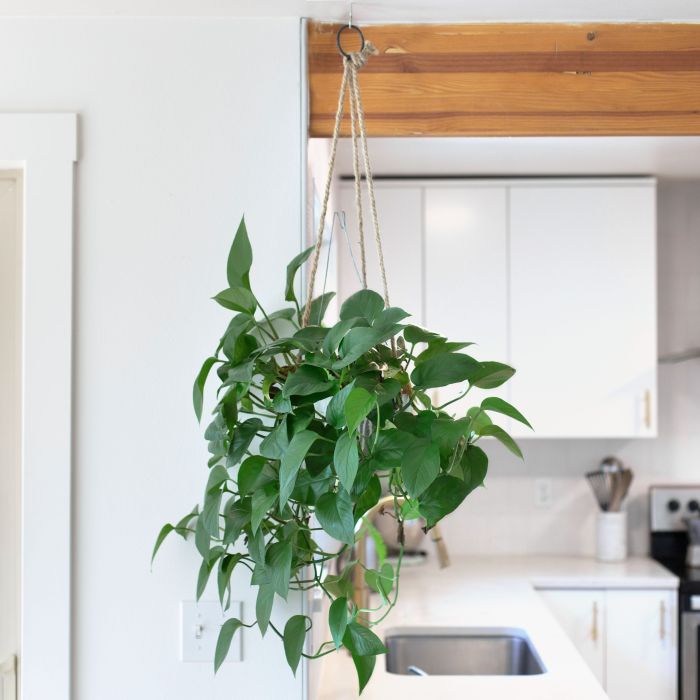
Hanging plants add a touch of greenery and life to any interior space. With their diverse styles and adaptability, they can complement various design aesthetics and enhance the ambiance of different rooms.
Easy to care for hanging house plants bring a touch of nature and tranquility to any room. From cascading pothos to trailing philodendrons, these plants add a touch of greenery without requiring constant attention. If you’re looking for a low-maintenance way to add some life to your space, consider easy care trailing house plants . They’re perfect for hanging baskets or trailing over shelves, and their forgiving nature makes them ideal for even the most novice plant parent.
Choosing the Right Style
Hanging plants come in a range of styles, each with unique characteristics:
-
-*Trailing
Hanging house plants are a great way to add some life to your home, and they can be surprisingly easy to care for. Easy care indoor hanging plants are a great option for those who don’t have a lot of time to spend on plant care.
These plants are typically low-maintenance and can tolerate a wide range of conditions. They’re also a great way to add some greenery to your home without taking up too much space.
These plants have long, cascading stems that gracefully drape over the edges of containers. Examples include pothos, spider plants, and English ivy.
-*Cascading
Similar to trailing plants, cascading varieties have shorter stems that create a more compact, bushy effect. They include ferns, begonias, and succulents like Echeveria.
-*Upright
These plants grow vertically, adding height and structure to a space. They include snake plants, ZZ plants, and parlor palms.
Complementing Interior Design Styles
Hanging plants can elevate the aesthetics of different interior design styles:
-
-*Bohemian
Trailing and cascading plants add a touch of bohemian flair, complementing macrame hangers and eclectic furnishings.
-*Minimalist
Upright plants with clean lines and simple silhouettes, such as snake plants or ZZ plants, enhance the sleek and modern ambiance of minimalist spaces.
-*Traditional
Cascading ferns or upright parlor palms bring a touch of elegance and classic charm to traditional interiors.
Incorporating into Specific Rooms
Hanging plants can enhance the functionality and aesthetics of various rooms:
-
-*Bedrooms
Trailing plants create a calming atmosphere and purify the air, making them ideal for bedrooms.
-*Living Rooms
Upright plants add height and structure to living areas, while cascading plants can soften harsh lines and create a cozy ambiance.
-*Kitchens
Herbs like basil and mint can be grown in hanging planters, adding freshness and functionality to kitchen spaces.
Final Thoughts: Easy To Care For Hanging House Plants
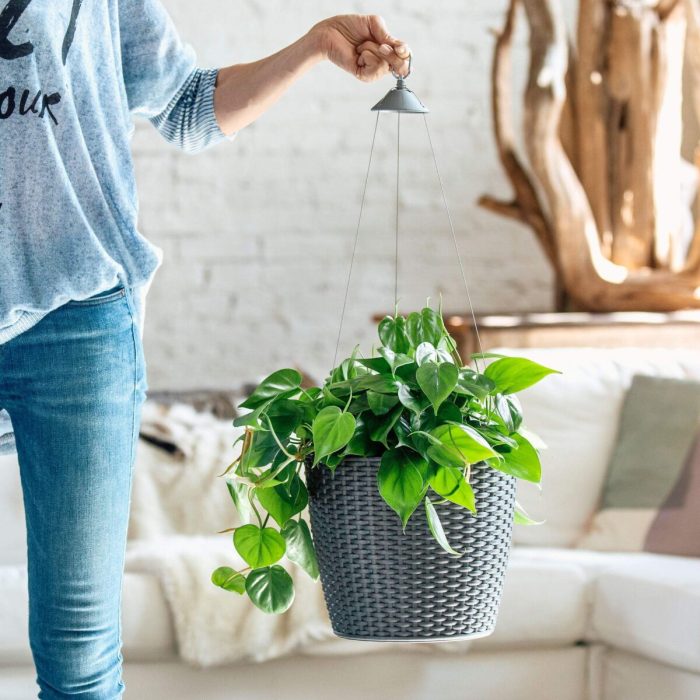
With the right care and attention, your easy to care for hanging house plants will thrive, adding a touch of beauty and tranquility to your indoor spaces. Embrace the joy of indoor gardening and enjoy the benefits of these verdant companions.
FAQ Compilation
What are the most popular easy to care for hanging house plants?
Some popular choices include pothos, spider plants, philodendrons, and ferns.
How often should I water my hanging plants?
Water when the top inch of soil feels dry to the touch, but avoid overwatering.
What is the best way to display hanging plants?
Use macrame hangers, wall-mounted brackets, or ceiling hooks to create a vertical garden effect.